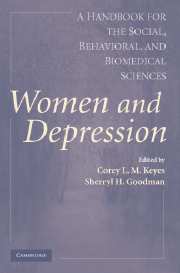Book contents
- Frontmatter
- Contents
- List of Contributors
- Foreword
- Preface
- PART I NOSOLOGY, MEASUREMENT, AND THE EPIDEMIOLOGY OF WOMEN AND DEPRESSION
- PART II BIOLOGICAL, DEVELOPMENTAL, AND AGING MODELS OF RISK
- PART III COGNITIVE, EMOTIONAL, AND INTERPERSONAL MODELS OF RISK
- PART IV SOCIAL, POLITICAL, AND ECONOMIC MODELS OF RISK
- 12 Social Suffering, Gender, and Women's Depression
- 13 Women, Work, and Depression
- 14 Culture, Race/Ethnicity, and Depression
- 15 Trauma and Depression
- 16 Public Health Approach to Depression and Women
- PART V SYSTEMS AND PROCESSES OF TREATMENT, PREVENTION, AND POLICY
- Author Index
- Subject Index
- References
16 - Public Health Approach to Depression and Women
The Case of the Disadvantaged Inner-City Woman
Published online by Cambridge University Press: 05 June 2012
- Frontmatter
- Contents
- List of Contributors
- Foreword
- Preface
- PART I NOSOLOGY, MEASUREMENT, AND THE EPIDEMIOLOGY OF WOMEN AND DEPRESSION
- PART II BIOLOGICAL, DEVELOPMENTAL, AND AGING MODELS OF RISK
- PART III COGNITIVE, EMOTIONAL, AND INTERPERSONAL MODELS OF RISK
- PART IV SOCIAL, POLITICAL, AND ECONOMIC MODELS OF RISK
- 12 Social Suffering, Gender, and Women's Depression
- 13 Women, Work, and Depression
- 14 Culture, Race/Ethnicity, and Depression
- 15 Trauma and Depression
- 16 Public Health Approach to Depression and Women
- PART V SYSTEMS AND PROCESSES OF TREATMENT, PREVENTION, AND POLICY
- Author Index
- Subject Index
- References
Summary
INTRODUCTION
Nobody knows what depression is, where it comes from or how I can make it go away. I am depressed, but so is my community. It is a community of trouble and struggle and there is little happiness.… Depression is having no hope, having no energy, having nothing to look forward to, always feeling pain … drugs allow me to get away from it.
[Quote from a 32-year-old female respondent who resides in a disadvantaged neighborhood and who uses cocaine daily]The focus of this chapter is on inner-city disadvantaged women and depression. According to the World Health Organization's Global Burden of Disease study, depression among women worldwide has been identified as the leading cause of disability adjusted life years among adult women worldwide today (Murray & Lopez, 1996). A similar picture has been presented by others (Kessler et al., 1994; National Institute of Mental Health, 1999). Compared to men, women have higher rates of initial onset of depression than men. Consequently, the number of females who experience a recurrence of a depressive episode is higher than that among their male counterparts (Kessler et al., 1994).
The burden of severe chronic mental disorders, including depression, is seen clearly among those at the greatest social and economic disadvantage in our societies (Kessler & Zhao, 1999; World Health Organization, 2000). In other words, a high prevalence of chronic mental disorders tends to be concentrated among a small proportion of the population (Kessler & Zhao, 1999).
- Type
- Chapter
- Information
- Women and DepressionA Handbook for the Social, Behavioral, and Biomedical Sciences, pp. 382 - 414Publisher: Cambridge University PressPrint publication year: 2006
References
- 1
- Cited by



